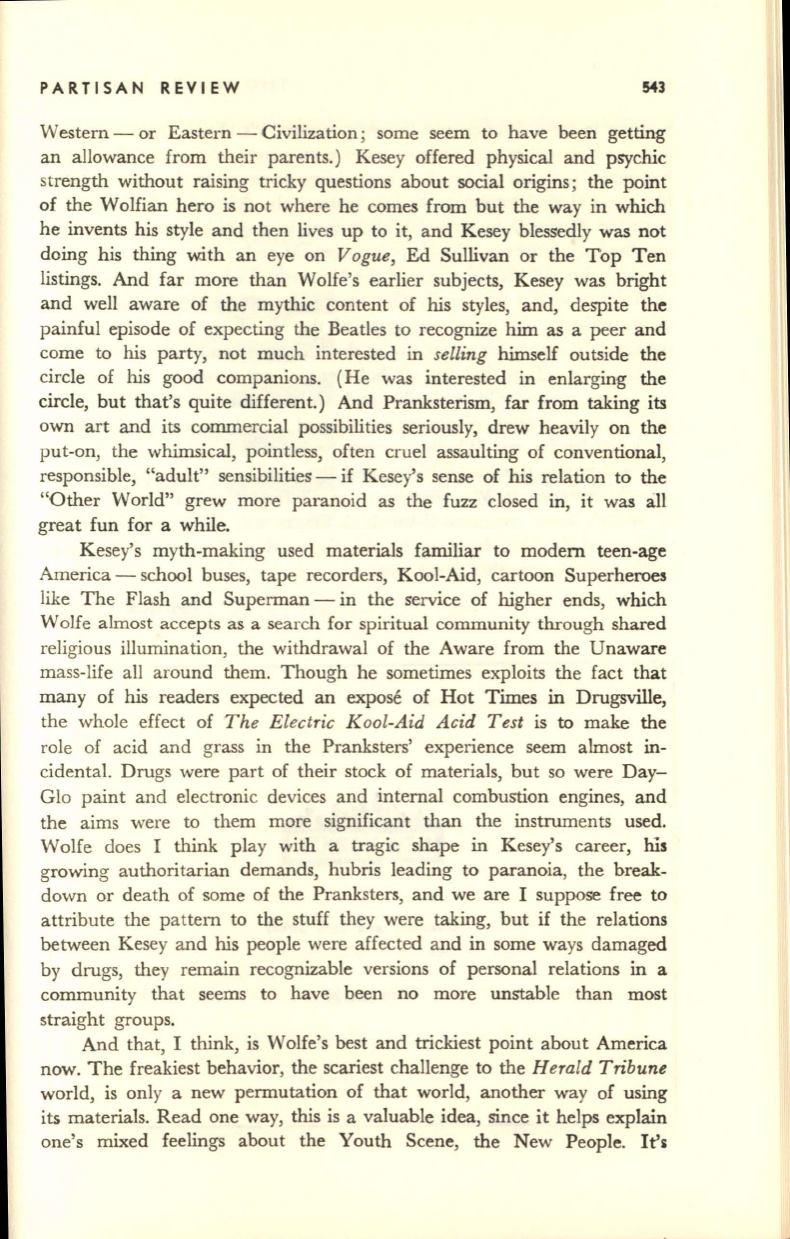
PARTISAN REVIEW
543
Western - or Eastern - Civilization; some seem to have been getting
an allowance from their parents.) Kesey offered physical and psychic
strength without raising tricky questions about social origins; the point
of the Wolfian hero is not where he comes from but the way in which
he invents his style and then lives up to it, and Kesey blessedly was not
doing his thing wjth an eye on
Vogue,
Ed Sullivan or the Top Ten
listings. And far more than Wolfe's earlier subjects, Kesey was bright
and well aware of the mythic content of his styles, and, despite the
painful episode of expecting the Beatles to recognize him as a peer and
come to his party, not much interested in
selling
himself outside the
circle of his good companions. (He was interested in enlarging the
circle, but that's quite different.) And Pranksterism, far from taking its
own art and its commercial possibilities seriously, drew heavily on the
put-on, the whimsical, pointless, often cruel assaulting of conventional,
responsible, "adult" sensibilities - if Kesey's sense of his relation to the
"Other World" grew more paranoid as the fuzz closed in, it was
all
great fun for a while.
Kesey's myth-making used materials familiar to modem teen-age
America - school buses, tape recorders, Kool-Aid, cartoon Superheroes
like The Flash and Superman - in the service of higher ends, which
Wolfe almost accepts as a search for spiritual community through shared
religious illumination, the withdrawal of the Aware from the Unaware
mass-life all around them. Though he sometimes exploits the fact that
many of his readers expected an expose of Hot Times in Drugsville,
the whole effect of
The Electric Kool-Aid Acid Test
is
to
make the
role of acid and grass in the Pranksters' experience seem almost in–
cidental. Drugs were part of their stock of materials, but so were Day–
Glo paint and electronic devices and internal combustion engines, and
the aims were to them more significant than the instruments used.
Wolfe does I think play with a tragic shape in Kesey's career,
his
growing authoritarian demands, hubris leading to paranoia, the break–
down or death of some of the Pranksters, and we are I suppose free to
attribute the pattern to the stuff they were taking, but if the relations
between Kesey and his people were affected and in some ways damaged
by drugs, they remain recognizable versions of personal relations in a
community that seems to have been no more unstable than most
straight groups.
And that, I think, is Wolfe's best and trickiest point about America
now. The freakiest behavior, the scariest challenge to the
Herald Tribune
world, is only a new permutation of that world, another way of using
its materials. Read one way, this is a valuable idea, since it helps explain
one's mixed feelings about the Youth Scene, the New People. It'li


